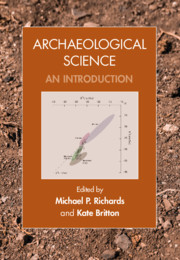Book contents
- Archaeological Science
- Archaeological Science
- Copyright page
- Contents
- Figures
- Tables
- Contributors
- Acknowledgements
- Part I Introduction
- Part II Biomolecular Archaeology
- Part III Bioarchaeology
- 7 Human Osteology
- 8 Dental Histology
- 9 Geometric Morphometrics
- Part IV Environmental Archaeology
- Part V Materials Analysis
- Part VI Absolute Dating Methods
- Index
- References
8 - Dental Histology
from Part III - Bioarchaeology
Published online by Cambridge University Press: 19 December 2019
- Archaeological Science
- Archaeological Science
- Copyright page
- Contents
- Figures
- Tables
- Contributors
- Acknowledgements
- Part I Introduction
- Part II Biomolecular Archaeology
- Part III Bioarchaeology
- 7 Human Osteology
- 8 Dental Histology
- 9 Geometric Morphometrics
- Part IV Environmental Archaeology
- Part V Materials Analysis
- Part VI Absolute Dating Methods
- Index
- References
Summary
Because they are highly mineralised, teeth are one of the best preserved and most commonly recovered elements in archaeological and fossil assemblages. They have inspired more than a century of comparative studies of hominin tooth size and shape (e.g., Bailey 2002; Brace et al. 1991; Dubois 1892; Hanihara 2008; Hanihara and Ishida 2005; Hooijer 1948; Irish and Guatelli-Steinberg 2003; Keith 1913; Le Gros Clark 1950; Weidenreich 1937; Wolpoff 1971; Wood et al. 1991). Additional valuable information is recorded on outer surfaces and inner aspects of the dental hard tissues (enamel, dentine, and cementum) that make up tooth crowns and roots, providing a permanent record of growth. Initial study of dental histology, or microscopic tooth structure, predates the fields of archaeology and evolutionary biology by several centuries. The innovative microscopist Anthony Leeuwenhoeck first described the structure of enamel in the 1600s, noting that it was made of longitudinal “pipes” (enamel prisms) that appeared as “globules” when viewed end-on (Leeuwenhoeck 1677–1678). During the 1800s and early 1900s, microscopic investigations revealed the tubular nature of dentine and the presence of successive temporal lines in enamel and dentine (reviewed in Dean 1995; Smith 2006). By the 1940s, American and Japanese teams had experimentally demonstrated the presence of circadian structural features, as well as the neonatal (birth) line, which allows one to relate developmental time to chronological (calendar) age in juvenile dentitions. These incremental features form the basis of a growing area of anthropological study that is illuminating aspects of human evolutionary developmental biology, as well as the health and demography of past human populations.
- Type
- Chapter
- Information
- Archaeological ScienceAn Introduction, pp. 170 - 197Publisher: Cambridge University PressPrint publication year: 2020
References
- 2
- Cited by

